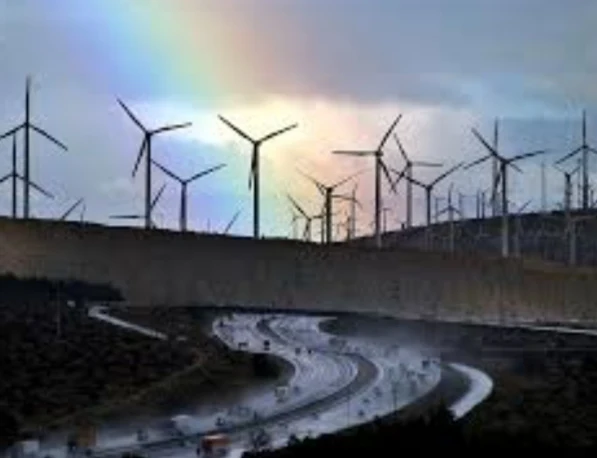A Timeline of Renewable Investment Funds: From Early Seeds to Global Growth
The history of renewable investment funds is a story of growing awareness, innovation, and increasing urgency in the fight against climate change.
Here's a glimpse into some key milestones:
Early Seeds (1970s-1990s):
- 1970s: Oil crises spark interest in alternative energy sources. First dedicated environmental funds and government initiatives emerge.
- 1980s: Focus shifts to sustainable development. Public-private partnerships like the Global Environment Facility (GEF) form.
- 1990s: The Kyoto Protocol ignites momentum for renewables. First dedicated renewable energy funds established, like the Renewable Energy Trust Capital (RETC).
Taking Root (2000s-2010s):
- 2000s: Microfinance and impact investing gain traction, fueling renewable projects in developing countries.
- 2007-2008: Global financial crisis slows progress, but underscores need for sustainable energy sources.
- 2010s: Green bonds rise in popularity, offering new avenues for investment. Multilateral development banks (MDBs) increase renewable energy lending.
Blossoming & Transformation (2020s):
- 2020s: COVID-19 recovery efforts highlight the need for "green" investments. Record levels of capital flow into renewables globally.
- 2021: COP26 further strengthens international commitment to climate action, boosting demand for renewable investments.
- 2022-present: Growing focus on equity and accessibility, ensuring developing countries benefit from the renewable energy transition. Policy advancements like the US Inflation Reduction Act incentivize further investment.
Key Trends:
- Diversification: Investment options grow beyond traditional wind and solar farms to include bioenergy, geothermal, and emerging technologies like hydrogen.
- Regional growth: Markets like China and India see significant investment alongside established players like Europe and North America.
- Impact focus: Investments increasingly consider not just financial returns but also environmental and social impact, promoting sustainable development.
- Technological evolution: Funds play a role in accelerating innovation and commercialization of new renewable technologies.
Looking Ahead:
The future of renewable investment funds appears bright. Continued policy support, technological advancements, and increasing investor interest suggest they will play a critical role in achieving a global clean energy transition. However, challenges remain, including mobilizing sufficient capital, ensuring equitable access, and harmonizing regulations across borders. By addressing these challenges, renewable investment funds can become even more effective tools for building a sustainable and just future.
Powering the Future: A Look at Renewable International Funds
The transition to a sustainable future heavily relies on the growth of renewable energy sources. To accelerate this shift, numerous international funds are playing a crucial role in channeling investments towards clean energy projects around the globe.
The Need for Renewable Investment:
Despite significant progress, global investment in renewables still falls short of the staggering $35 trillion needed by 2030 to achieve climate and development goals. This gap highlights the vital role of international funds in bridging the financing gap and unlocking the potential of renewable energy.
Key Players in the Renewable Funding Landscape:
- Public-Private Partnerships (PPPs): These combine public and private resources to maximize the impact of investments. Examples include the Global Energy Efficiency and Renewable Energy Fund (GEEREF) and the IKEA Foundation - Rockefeller Foundation $1 billion fund for distributed renewable energy in emerging economies.
- Multilateral Development Banks (MDBs): The World Bank, Asian Development Bank, and others offer financing and technical assistance for renewable energy projects in developing countries.
- Impact Investment Funds: These funds prioritize both financial returns and positive environmental and social impact. They invest in a range of renewable energy projects, from solar and wind farms to geothermal and biomass ventures.
- Green Bonds: These debt instruments raise capital specifically for climate-friendly projects, including renewable energy infrastructure.
Benefits of Renewable International Funds:
- Scaling Up Investment: By pooling resources, these funds attract larger investments that wouldn't be possible for individual projects.
- Geographical Reach: International funds can support projects in developing countries where access to finance is limited, enabling a more equitable transition to renewables.
- Technology Innovation: Some funds focus on investing in cutting-edge renewable technologies, accelerating their development and commercialization.
- Risk Mitigation: By diversifying their portfolios across different countries and technologies, these funds mitigate risks for investors.
Challenges and Opportunities:
- Mobilizing More Capital: Attracting additional private sector investment remains crucial to meet the ambitious funding needs.
- Ensuring Equity and Access: Ensuring equitable access to renewable energy investments and benefits for developing countries is critical.
- Harmonizing Regulations: Streamlining international regulations can further facilitate cross-border investments in renewables.
The Future of Renewable International Funds:
As the urgency for climate action grows, renewable international funds are poised to play an even more significant role in shaping the future of energy. By addressing existing challenges and capitalizing on opportunities, these funds can be instrumental in driving a sustainable and equitable global energy transition.
The Need for Renewable Investment Funds
The need for renewable investment funds stems from a complex interplay of environmental, economic, and social factors:
Environmental Imperative:
- Climate Change: We face an urgency to transition away from fossil fuels, the primary driver of climate change, to avoid catastrophic consequences. Renewables offer a path to clean energy generation, mitigating greenhouse gas emissions and slowing global warming.
- Resource Depletion: Fossil fuels are finite resources, and their continued reliance threatens both energy security and environmental sustainability. Renewables offer a long-term, sustainable solution.
- Pollution and Health: Fossil fuel combustion contributes significantly to air and water pollution, harming human health and ecosystems. Renewables offer cleaner alternatives, improving public health and environmental quality.
Economic Drivers:
- Job Creation: The renewable energy sector is a significant job creator, offering opportunities in manufacturing, installation, maintenance, and research. Investment in renewables can stimulate economic growth and diversification.
- Energy Security: Reliance on imported fossil fuels leaves countries vulnerable to price fluctuations and geopolitical instability. Renewables offer energy independence and security, particularly for countries with abundant renewable resources.
- Cost competitiveness: Renewable energy costs have been falling rapidly, reaching grid parity in many regions. Increasing investment can further drive down costs, making renewables the most economical option in the long run.
Social Equity:
- Energy Access: Many communities, particularly in developing countries, lack access to reliable and affordable energy. Renewable investment can bridge this gap by providing clean energy solutions, improving livelihoods and promoting development.
- Community ownership: Investing in locally-owned and operated renewable projects can empower communities, fostering participation and promoting social justice.
- Climate justice: The impacts of climate change are disproportionately felt by vulnerable communities. Investment in renewables can contribute to a more just transition, ensuring everyone benefits from a clean energy future.
Beyond these overarching benefits, specific needs create demand for diverse renewable investment funds:
- Developing countries: Many developing countries lack the financial resources and technical expertise to develop their renewable energy sectors. Targeted funds can provide crucial support.
- Emerging technologies: Early-stage renewable technologies often require specialized investment to bridge the gap between research and commercialization.
- Specific regions or communities: Dedicated funds can address unique challenges and opportunities in specific geographic areas or communities.
The need for renewable investment funds is multifaceted, driven by environmental urgency, economic opportunities, and social imperatives. These funds play a crucial role in accelerating the transition to a clean energy future, benefiting the planet, economies, and communities worldwide.
Key Players in Renewable Energy Funding and Investment Data
Here's a combined response considering your previous inputs and incorporating data on investment numbers:
International Organizations:
- IRENA:
- 2021 Global Renewables Investment: $366 billion (excluding large hydro)
- Data source: Global Renewables Outlook 2023
- IEA:
- 2021 Clean Energy Investment: $1.3 trillion (includes electric vehicles)
- Data source: World Energy Investment 2022
- IPCC:
- Provides qualitative assessments, not specific investment numbers.
Financial Institutions:
- GCI:
- $165 billion committed to climate action projects since 2015, with some dedicated to renewables.
- Data source: Website
- World Bank:
- $32 billion invested in renewable energy projects in 2022.
- Data source: Website
- Regional Development Banks:
- Varying individual figures, but collectively invested hundreds of billions in renewables.
- Data sources: Individual bank website
Private Investors:
- Venture Capital & Private Equity:
- Invested $35.2 billion in clean energy technologies in 2022 (BNEF data).
- Institutional Investors:
- Allocated $841 billion to sustainable assets in 2022 (GSR Institute report).
- Crowdfunding Platforms:
- Difficult to track total investment figures, but platforms like WeAreWaterFunding & SunFunder are active.
Data & Analysis Providers:
- BNEF:
- Tracks global clean energy investments with detailed reports and datasets.
- Pricing varies depending on specific subscriptions.
- Mercom Capital:
- Tracks clean energy deals with data on venture capital & private equity.
- Pricing varies depending on specific subscriptions.
- REN21:
- Provides annual reports on global renewable energy trends, including finance.
- Free reports available on their website.
National Governments:
- Varying levels of investment depending on policies and programs.
- Data sources: Individual government websites or reports like REN21.
Investment Numbers:
- Remember, numbers vary depending on definitions, data sources, and timeframes.
Here's a combined response considering your previous inputs and incorporating data on investment numbers:
International Organizations:
- IRENA:
- 2021 Global Renewables Investment: $366 billion (excluding large hydro)
- Data source: Global Renewables Outlook 2023
- IEA:
- 2021 Clean Energy Investment: $1.3 trillion (includes electric vehicles)
- Data source: World Energy Investment 2022
- IPCC:
- Provides qualitative assessments, not specific investment numbers.
Financial Institutions:
- GCI:
- $165 billion committed to climate action projects since 2015, with some dedicated to renewables.
- Data source: Website
- World Bank:
- $32 billion invested in renewable energy projects in 2022.
- Data source: Website
- Regional Development Banks:
- Varying individual figures, but collectively invested hundreds of billions in renewables.
- Data sources: Individual bank website
Private Investors:
- Venture Capital & Private Equity:
- Invested $35.2 billion in clean energy technologies in 2022 (BNEF data).
- Institutional Investors:
- Allocated $841 billion to sustainable assets in 2022 (GSR Institute report).
- Crowdfunding Platforms:
- Difficult to track total investment figures, but platforms like WeAreWaterFunding & SunFunder are active.
Data & Analysis Providers:
- BNEF:
- Tracks global clean energy investments with detailed reports and datasets.
- Pricing varies depending on specific subscriptions.
- Mercom Capital:
- Tracks clean energy deals with data on venture capital & private equity.
- Pricing varies depending on specific subscriptions.
- REN21:
- Provides annual reports on global renewable energy trends, including finance.
- Free reports available on their website.
National Governments:
- Varying levels of investment depending on policies and programs.
- Data sources: Individual government websites or reports like REN21.
Investment Numbers:
- Remember, numbers vary depending on definitions, data sources, and timeframes.
Key Players in Renewable Energy Funding and Investment Data (Table)
Category Player Investment Data (2022 unless specified) Data Source Notes International Organizations IRENA $366 billion (global, excl. large hydro) Global Renewables Outlook 2023 2021 data IEA $1.3 trillion (global, incl. electric vehicles) World Energy Investment 2022 Includes all clean energy, not just renewables IPCC N/A Reports and assessments Qualitative analysis, not specific investment numbers Financial Institutions GCI $165 billion committed since 2015 Website Committed funds, not annual investment World Bank $32 billion Website 2022 data Regional Development Banks Varies Individual bank websites Collective figure likely in hundreds of billions Private Investors VC & PE $35.2 billion (global, clean energy tech) BNEF 2022 data Institutional Investors $841 billion (sustainable assets) GSR Institute report 2022 data Crowdfunding Platforms N/A WeAreWaterFunding, SunFunder Difficult to track total figures Data & Analysis Providers BNEF Varies Website Paid subscriptions for detailed data Mercom Capital Varies Website Paid subscriptions for specific data REN21 N/A Website Free reports, annual data National Governments Varies Individual government websites, REN21 Varies depending on country and program
| Category | Player | Investment Data (2022 unless specified) | Data Source | Notes |
|---|---|---|---|---|
| International Organizations | IRENA | $366 billion (global, excl. large hydro) | Global Renewables Outlook 2023 | 2021 data |
| IEA | $1.3 trillion (global, incl. electric vehicles) | World Energy Investment 2022 | Includes all clean energy, not just renewables | |
| IPCC | N/A | Reports and assessments | Qualitative analysis, not specific investment numbers | |
| Financial Institutions | GCI | $165 billion committed since 2015 | Website | Committed funds, not annual investment |
| World Bank | $32 billion | Website | 2022 data | |
| Regional Development Banks | Varies | Individual bank websites | Collective figure likely in hundreds of billions | |
| Private Investors | VC & PE | $35.2 billion (global, clean energy tech) | BNEF | 2022 data |
| Institutional Investors | $841 billion (sustainable assets) | GSR Institute report | 2022 data | |
| Crowdfunding Platforms | N/A | WeAreWaterFunding, SunFunder | Difficult to track total figures | |
| Data & Analysis Providers | BNEF | Varies | Website | Paid subscriptions for detailed data |
| Mercom Capital | Varies | Website | Paid subscriptions for specific data | |
| REN21 | N/A | Website | Free reports, annual data | |
| National Governments | Varies | Individual government websites, REN21 | Varies depending on country and program |
Internasional Renewable Energy Investment Funds Ongoing Projects
International Renewable Energy Investment Funds Ongoing Projects:
Several international funds are actively supporting renewable energy projects worldwide, aiming to combat climate change and promote sustainable development. Here are some notable examples with specific projects and data:
Green Climate Fund (GCF):
- Project: Scaling-up Mini-grids in Rural Bangladesh (Bangladesh) - Aims to install 1,000 mini-grids, benefiting 4 million people with clean energy access by 2025. (Approved amount: USD 95 million)
- Project: Scaling Up Renewable Energy in Small Island Developing States (SIDS) - Supports renewable energy development in 12 SIDS countries, aiming to avoid 2.5 million tons of CO2 emissions annually by 2030. (Approved amount: USD 150 million)
Global Off-Grid Solar Fund (GOSF):
- Project: Energizing Off-Grid Healthcare Facilities in Africa - Provides solar power to 400 healthcare facilities in 10 African countries, improving healthcare access and resilience. (Investment mobilized: USD 10 million)
- Project: Scaling Up Solar Home Systems in East Africa - Finances mini-grids and solar home systems in Uganda and Tanzania, benefiting 1 million people with clean energy by 2024. (Investment mobilized: USD 20 million)
Climate Bonds Initiative (CBI):
- Project: Green Panda Bond (China) - Issued by the People's Bank of China, raised USD 5.5 billion for green infrastructure projects, including renewable energy.
- Project: US Corporate Green Bond Market - Supported issuance of over USD 300 billion in US corporate green bonds, funding various renewable energy projects.
International Finance Corporation (IFC):
- Project: Scaling Up Solar in Vietnam - Supports development of 2.2 GW of rooftop solar capacity, creating jobs and reducing emissions. (Investment: USD 200 million)
- Project: Wind Power Development in Morocco - Financed construction of a 300 MW wind farm, increasing renewable energy share in the national grid. (Investment: USD 220 million)
Asian Development Bank (ADB):
- Project: Scaling Up Renewable Energy in India - Supports various renewable energy projects, including solar, wind, and biomass, aiming to add 10 GW of capacity by 2022. (Investment: USD 1 billion)
- Project: Geothermal Power Development in Indonesia - Finances development of a 50 MW geothermal power plant, providing clean and reliable energy. (Investment: USD 200 million)
These are just a few examples, and numerous other funds and projects contribute to the global advancement of renewable energy. Remember, this information is dynamic, and project details and data might change over time.
The Future of Renewable Energy International Funds
The future of renewable energy is bright, and international funds are playing a major role in driving its growth. Here are some key trends to watch:
Increasing investment: Global investment in renewable energy reached a record high of $332 billion in 2022, and is expected to continue growing in the coming years. This is being driven by a number of factors, including:
- Climate change concerns: There is a growing consensus that we need to transition to renewable energy sources to address climate change.
- Cost competitiveness: The cost of renewable energy has fallen dramatically in recent years, making it increasingly competitive with traditional fossil fuels.
- Government policies: Many governments are introducing policies to support renewable energy, such as feed-in tariffs and renewable energy mandates.
Emerging markets: A significant portion of future growth is expected to come from emerging markets, such as India, China, and Brazil. These countries have large populations and growing energy needs, and they are increasingly looking to renewable energy to meet those needs.
New technologies: There is a constant stream of innovation in the renewable energy sector, with new technologies emerging all the time. These new technologies have the potential to make renewable energy even more affordable and efficient.
Integration with other sectors: Renewable energy is increasingly being integrated with other sectors, such as transportation and heating. This is creating new opportunities for investment and growth.
Challenges: Despite the positive outlook, there are also some challenges that need to be addressed. These include:
- Grid integration: Integrating large amounts of renewable energy into the grid can be challenging.
- Storage: There is a need for more efficient and affordable ways to store renewable energy.
- Policy uncertainty: Changes in government policy can create uncertainty for investors.
International funds: International funds are playing a vital role in addressing these challenges and supporting the growth of renewable energy. They are doing this by:
- Providing finance: International funds are investing in renewable energy projects around the world.
- Sharing expertise: International funds can help to share expertise and best practices between different countries.
- Advocating for policy change: International funds can advocate for policies that support renewable energy.
Here are some specific examples of international funds that are investing in renewable energy:
- The Green Climate Fund: The Green Climate Fund is a global fund that provides finance to developing countries for climate change mitigation and adaptation projects.
- The World Bank: The World Bank is a major investor in renewable energy projects around the world.
- The European Investment Bank: The European Investment Bank is a leading investor in renewable energy in Europe.
The future of renewable energy is full of potential, and international funds are playing a key role in making it a reality. With continued investment and innovation, renewable energy can help us to create a cleaner, more sustainable future.








